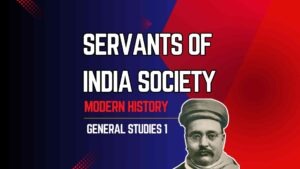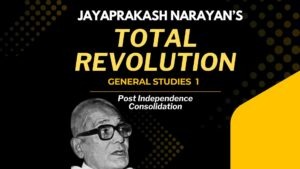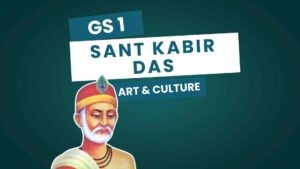Sant Kabir Das
Table of Contents
Sant Kabir Das
In NEWS:
Sant Kabir Das Jayanti celebrated on June 11, 2025, marks his 648th birth anniversary.
Celebrated for his role in spiritual unity, Bhakti movement, and social reform.
🟩 BIOGRAPHICAL DETAILS
Born: ~1440 CE, Varanasi, Uttar Pradesh.
Raised by: A Muslim weaver family (Julaha caste) – symbol of religious syncretism.
Era: 15th century – during the height of the Bhakti movement.
Profession: Weaver (also known for his simple lifestyle).
🟩 MAJOR WORKS of Sant Kabir Das
Bijak
Literally means “The Seedling” – a compilation of Kabir’s philosophical verses.
Contains poems, dohas (couplets), and ramainis that reflect his ideas on truth, devotion, and rejection of religious orthodoxy.
Written in simple, rustic language, promoting Nirguna Bhakti and spiritual introspection.
Sakhi Granth
A collection of ‘sakhis’ or couplets, meant to convey moral and spiritual teachings.
Focuses on practical wisdom, inner purity, and the futility of external rituals.
Emphasizes ethical conduct, simplicity, and the remembrance of God.
Kabir Granthavali
Compiled by scholars, it contains Kabir’s verses in various regional dialects.
Reflects his mystical and reformist thoughts, often challenging casteism and dogma.
Offers insight into his role as a Bhakti poet and social reformer.
Anurag Sagar
A metaphysical dialogue between Kabir and his disciple Dharamdas.
Explores the battle between truth and illusion (Maya) and the origin of the soul’s entrapment.
Highlights his vision of spiritual liberation through devotion and wisdom.
Verses in Guru Granth Sahib
Nearly 541 verses of Kabir are included.
Selected by Sikh Gurus for their universal message of devotion, equality, and truth.
Reinforces his role as a bridge between Hindu and Islamic traditions.
🟩 PHILOSOPHY & TEACHINGS
🔹 Spiritual Ideas
Nirguna Bhakti:
Rejected idol worship & ritualistic religion.
Advocated devotion to a formless, universal God (Nirguna Brahman).
Inner Divinity:
God resides within the individual, not in temples or rituals.
Urged self-realization through introspection and simplicity.
Namsmaran:
Remembering the name of God with devotion and humility.
🔹 Social Reform
Strong opposition to caste system and religious orthodoxy.
Believed in equality of all human beings regardless of religion, caste, or gender.
Advocated ethical living, compassion, and non-violence (Ahimsa).
Championed seva (service) and simple living.
🟩 INFLUENCE AND LEGACY
🔹 Spiritual Sects & Movements
Kabir Panth:
A sect founded on his teachings; active in northern India even today.
Influence on Sikhism:
Guru Nanak respected Kabir.
His verses included in the Guru Granth Sahib.
Dadu Panthis and others:
Inspired inclusive Bhakti movements that rejected ritualism and caste hierarchy.
Revered by both Hindus and Muslims – promoted religious harmony.
🟩 RELEVANCE IN MODERN TIMES (GS1/GS4/Essay)
| Aspect | Relevance |
|---|---|
| Religious Harmony | Promotes unity in a world divided by sectarianism. |
| Social Justice | Critique of caste and privilege aligns with constitutional values. |
| Simplicity & Sustainability | Advocated contentment and minimalism, vital in today’s consumerist world. |
| Humanism > Ritualism | Emphasizes ethical conduct over hollow rituals. |
| Spiritual Pluralism | Respects all paths to truth – ideal for India’s pluralistic ethos. |
Mains-Based Questions on Sant Kabir Das
❓Q1. “Sant Kabir Das was a revolutionary who reshaped the Bhakti movement into a tool of social transformation.” Discuss.
🔷Answer Framework:
Introduction:
Briefly introduce Sant Kabir Das as a 15th-century Bhakti saint and poet, known for Nirguna Bhakti and egalitarian philosophy.
Body:
Reshaping Bhakti Movement:
Shifted focus from ritualistic devotion to inner spirituality and personal connection with the divine.
Advocated Nirguna Bhakti – worship of a formless, universal God.
Social Transformation:
Rejected caste-based hierarchy, Brahmanical dominance, and religious dogmas.
Promoted human dignity, compassion, and Ahimsa.
Championed social equality and inclusivity across religious lines.
Tools of Change:
Used vernacular language (Hindi/Avadhi) in dohas and sakhis to reach the masses.
Inspired Kabir Panth, influenced Sikhism and other sects.
Lived a life of simplicity, practicing what he preached.
Conclusion:
Kabir’s contribution transcended poetry; he redefined Bhakti as a vehicle for spiritual enlightenment and social justice, making him a timeless reformer.
❓Q2. “Kabir’s teachings reflect a deep concern for social justice, spiritual universality, and ethical conduct.” Examine in the context of his relevance in the modern world.
🔷Answer Framework:
Introduction:
Mention Kabir as a Bhakti saint whose dohas offer insight into spiritual wisdom and ethical life.
Body:
Social Justice:
Critiqued casteism and ritual pollution, upheld dignity for all.
Aligned with constitutional values like equality and secularism.
Spiritual Universality:
Advocated Nirguna Bhakti – beyond forms, rituals, and sectarian boundaries.
Verses included in Guru Granth Sahib – showing interfaith appeal.
Ethical Living:
Emphasized self-realization, humility, and Namsmaran (remembering God’s name).
Rejected external rituals in favor of internal purity and conduct.
Contemporary Relevance:
Lessons in tolerance, minimalism, and inclusivity in a polarized world.
Inspires spiritual humanism beyond religious divisions.
Conclusion:
Kabir remains relevant as a guiding light of ethical clarity and inclusive spirituality, offering tools to combat modern-day divisiveness and moral confusion.
❓Q3. “Sant Kabir Das challenged religious orthodoxy and opened the doors of spirituality to the common people.” Elaborate.
🔷Answer Framework:
Introduction:
Briefly introduce Kabir’s background and spiritual mission.
Body:
Challenge to Orthodoxy:
Criticized both Brahmanical rituals and Islamic formalism.
Condemned idol worship, meaningless fasts, and pilgrimages.
Accessible Spirituality:
Composed in vernacular (local dialects) – spoke directly to the common masses.
Advocated Naam Simran (remembering God), ethical conduct, and seva.
Inclusivity:
Revered by Hindus and Muslims alike.
Promoted non-sectarian path to God.
Legacy:
Formation of Kabir Panth as a popular Bhakti sect.
Verses in Guru Granth Sahib – proof of cross-religious respect.
Conclusion:
Kabir democratized spirituality, giving voice to the marginalized and challenging the priestly monopoly over religion.
Prelims Questions based on Sant Kabir Das
-
Important Mountain Ranges in India
When preparing for UPSC, mapping is crucial. The exam often... -
Important Indian Maps – Political Boundaries
Important Indian Maps - Political Boundaries of India comprises of... -
Servants of India Society – Important UPSC Notes
Servants of India Society was founded by Gopal Krishna Gokhale.... -
Sea Level Rise at India’s Coastal Region – Important UPSC Notes
The World Meteorological Organization (WMO) released its State of the... -
Indian Urban Drainage Crisis – Important UPSC Notes
The post "Indian Urban Drainage Crisis" talks about the issue... -
Jayaprakash Narayan Important UPSC Notes
Commemorating the 51st anniversary of Jayaprakash Narayan’s (JP) “Total Revolution”... -
Sant Kabir Das – UPSC Notes
Sant Kabir Das Jayanti was celebrated on June 11, 2025,...








